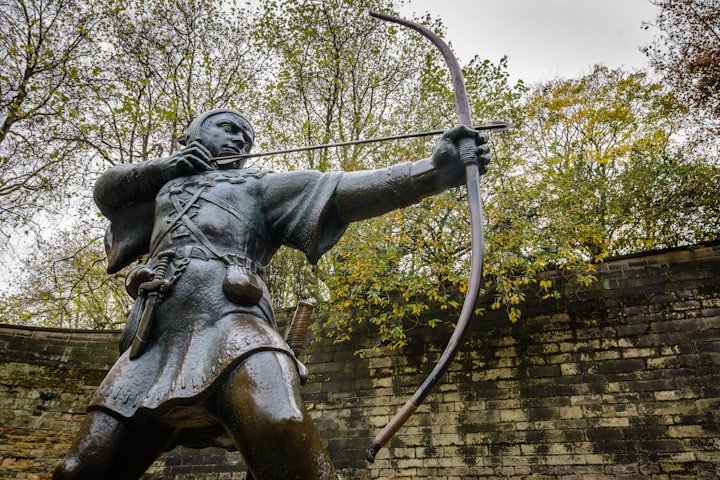How to Shoot a Longbow
The Art of Doing Nothing, Perfectly.

Archery is the art of doing nothing, perfectly, every single time. It's the archer's job to let the bow do all the work. I taught archery for two summers at the end of my teenage years, nearly a decade ago. It seemed like an appropriate job for an energetic millenial who adored anything that had to do with targets and hitting them with sharp projectiles. I instructed all sorts of people, from the elderly to middle-aged parents to bow-hunters to pop-culture obseesed teens to lots and lots of children. I made a lot of observations on all my students: for instance, dancers were able to pick up archery the quickest; the cutest little girl was the worst student of all time and made a hardened military-drill-sergeant-turned-instructor want to drink; the most stressful class was full of high-school students, none of whom could speak English; and pro hockey players took up bow hunting just for shits.
I got myself certified and specialized in traditional archery. I loved the elegance of the old-timey equipment compared to the new stuff, which sometimes looked straight out of a sci-fi movie. For a while, my life centred around it, exploring every application archery could possibly have as it reached a height in popularity unseen since the '70s. I even built an archery program for a summer camp from scratch and wrote a 100-page beginner's manual filled with everything I knew. Consider the following a massively condensed guide on shooting a longbow.
1. Equipment. Traditional shooters will tend to go for recurve bows over longbows because they’re faster and snappier. Longbows are like rubber bands, recurves are like springs. In my honestly biased opinion, longbows are far superior, due to the comfort and smoothness they provide. Arrows are usually built of carbon fibre but painted to look like wood and hand-built to look more authentic. Fletching is generally made of finely cut plastic or nylon compounds; very few arrows nowadays use actual feathers. Tips are blunted for safety.
2. Stance. The shooter will stand perfectly perpendicular to their target. Compound (ie Modern) shooting allows for a more open stance, but the margin for error in traditional shooting is nonexistant, so the shooter must focus on their stance first and foremost. Feet shoulder-width apart, hips, back, and shoulders straight. Keeping the back straight requires a lot more core strength than one would think. Shoulders stay relaxed, head is straight, as if an invisible string is attached to the shooter’s hair and pulling it toward the ceiling.
3. Bow hand. The hand that holds the bow. Gripping the riser like a hockey stick will only result in inaccuracy and bruises. To hold the bow, the shooter extends their arm and holds out their hand like a stop-sign. The bow rests against the base of the thumb, with a finger or two wrapping around for stability. An eight year old was better at this than a full-grown man who had been shooting for eight years (looking at you, pro hockey player).
4. Nocking the arrow. The arrow should be attached to the string with the index fletching (the odd-coloured fletching), facing outwards. Once the arrow is attached and on the rest, hands off. Touching the arrow will only make it come off the rest.
5. Draw. Using the preferred release method, ususally the fingers, the shooter will draw the bow string. I instructed my students to hold the string with three fingers, one on top of the arrow, two below (DO NOT TOUCH THE ARROW OR GRIP THE STRING LIKE A KID ON A SUGAR RUSH WITH A FREEZIE), tucking the thumb away. The shooter will draw back to their preferred anchor point, usually so the top finger on the string rests on the corner of the mouth like it’s a fish hook (DO NOT STICK YOUR FINGERS IN YOUR MOUTH, DAVID).
6. Aim. The shooter will focus their sight on the target in front of them, allowing their body to aim the arrow toward its intended destination. It’s akin to throwing a ball. (DON’T TRY TO LINE UP YOUR ARROW WITH YOUR EYEBALL, COEN)
7. Release. The string will slip off the fingers with the slightest relaxation of the hand. The draw hand will stay against the face after release. If the shooter hasn’t removed their dangly earrings, nose rings, scarves, or put their hair back, you can kiss those things goodbye because the string may rip piercings right out of your head. Especially nose rings. McKenzie learned that the hard way.
8. Follow-through. The shooter will allow their shoulders and arms to relax at their sides, ready for the next arrow (YOU DON’T NEED TO DO A SUN SALUTATION AFTER EVERY RELEASE, JOHNNY).
And that’s all there’s to it. Safety, of course, is imperative, and there are rules at every archery range to protect the shooters and equipment from injury and malfunction.
Shooting a bow is like riding a bike. Once you learn, you'll never forget it.
About the Creator
Niki Block
Author of Polaris: Contagion
Landscaper, parent, outdoor enthusiast, writer of all sorts of stuff






Comments
There are no comments for this story
Be the first to respond and start the conversation.